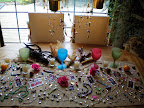

The origins of Halloween, may have begun with Roman festivals of harvest, but is typically linked to the Celtic festival of Samhain (pronounced sow-an or sow-in)",which is derived from the Old Irish and means roughly "summer's end."
The festival of Samhain celebrates the end of the "lighter half" of the year, and beginning of the "darker half", and is sometimes regarded as the "Celtic New Year." It is believed that the border between this world and the otherworld became thin on Samhain, allowing spirits (both harmless and harmful) to pass through. The family's ancestors were honored and invited home whilst harmful spirits were warded off. It is believed that the need to ward off harmful spirits led to the wearing of costumes and masks. Their purpose was to disguise oneself as a harmful spirit and thus avoid harm.
All Saints Day, or All Hallows or Hallowmas, is a Christian feast day celebrated on November 1, or the first Sunday after Pentecost. It a day meant to honor all of the saints, both known and unknown. Because Halloween preceded this feast day, that day actually took it's name from this feast day and thus became "The Eve of All Hallows', and eventually 'Hallowe'en'.
In the Christian West, All Saints Day honors those who have attained beatific vision in heaven, while November 2, All Soul's Day, commemorates the departed faithful who have not been so purified and entered heaven. In the tradition of using holy names taken from the Greek, early names such as All Hallowmas referred to hallowed or saintly, and mas, to the early Christian mass.
The Day of the Dead (Día de los Difuntos or Día de los Muertos) is a holiday celebrated mainly in Mexico and the Mexican immigrant community living in the United States. The holiday is based on the complicated blended cultures of their ancestors, the Aztec and Maya, and the Spanish invaders, layered with Catholicism.
For more than 500 years, the goddess Mictecacihuatl (Lady of the Dead) presided over Aztec harvest rituals using fires and incense, costumes of animal skins, images of their dead and offerings of ceramics, personal goods, flowers and foods, drink and flowers.
The Aztec, Mayan and other indigenous traditions have enriched the Mexican's attitude about death. From these ancestors has come the knowledge that souls continue to exist after death, resting placidly in Mictlan, the land of the dead, not for judgment or resurrection; but for the day each year when they could return home to visit their loved ones.
Los Dias de Los Muertos is a time for remembering friends, family and ancestors. In the Mexican tradition, people die three deaths. The first death is when our bodies cease to function; when our hearts no longer beat of their own accord, when our gaze no longer has depth or weight, when the space we occupy slowly loses its meaning. The second death comes when the body is lowered into the ground, returned to mother earth, out of sight. The third death, the most definitive death, is "when there is no one left alive to remember us."
The act of preparing an altar by placing photographs, flowers, candles, favorite foods and drink of the loved one provides a special time to remember, and to transform grief into acceptance. The living invite the spirits of the family to return home for a few hours of laughter, tears and memories.
Once the night has passed, and the spirits have returned to their world, the ones remaining know that for another year they have triumphed in the struggle of life and that the only way to celebrate death is to live with courage.
shown:
Traditional crepe paper roses, art cards and figurines as symbolic representations of both life and death, candles to light the way for the dead, goblets of water, candy, and packets of the salt. By using these symbols to represent the spirit of the dead, we honor them and their courage and ability to survive the physical world and live a life everlasting. We honor these days to symbolically keep the thin wall between us separated during the rest of the year. We remain safe in the present while we remember and honor the past.

5 comments:
Aren't all the different ways folks celebrate this time of year so wonderful? I love it! For me (and my Celtic heritage), I'm a Samhain celebrant.
I always learn so much from this blog. You have more information, more creative ideas, and are the nicest quilter of all of the blogs that I read! Hope you had a great Halloween.
Your table setting is very creative and the art cards are wonderful. May the thin veil stay in its place for you during these 3 days *VBG*
This is beautiful and very well done. Love all the unusual information.
Now that was interesting for sure...and I thought it was just about getting as much candy as you could in your paper bag without it ripping. :0)
Post a Comment